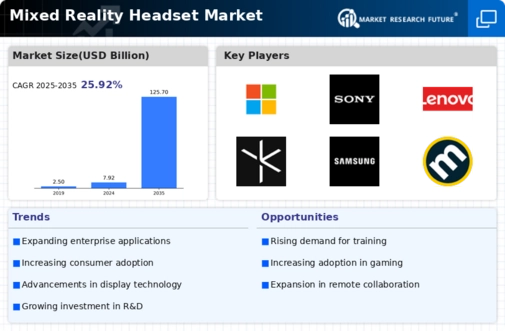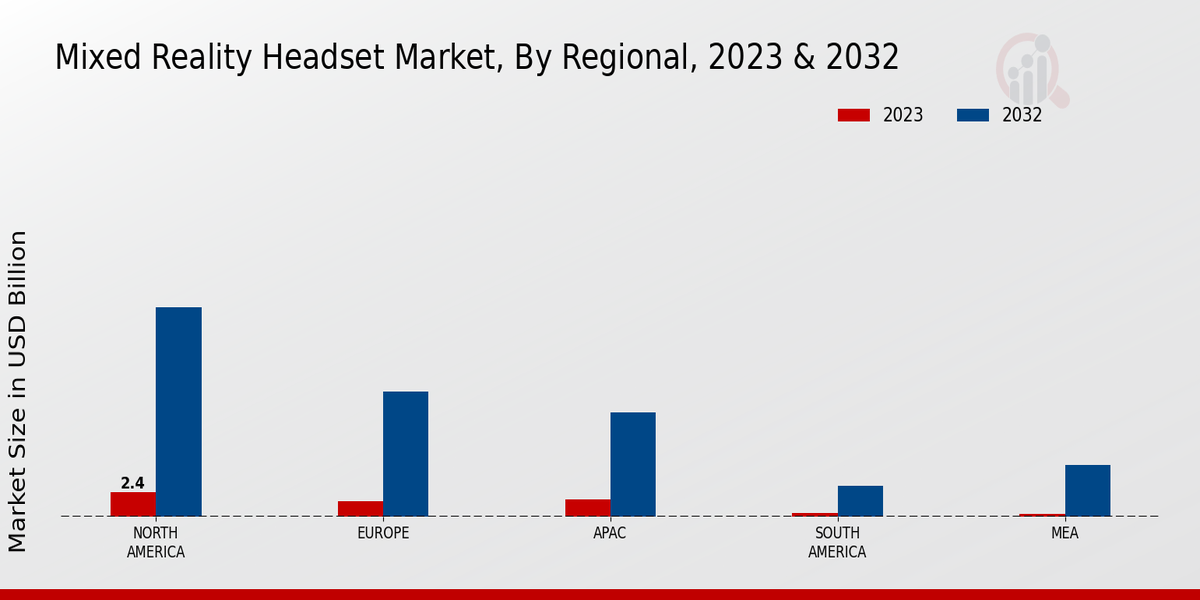Market Growth Projections
The Global Mixed Reality Headset Market Industry is projected to experience substantial growth, with forecasts indicating a market value of 7.92 USD Billion in 2024 and an impressive 125.7 USD Billion by 2035. The compound annual growth rate is estimated at 28.58% from 2025 to 2035, reflecting the increasing adoption of mixed reality technologies across various sectors. This growth is driven by advancements in technology, expanding applications in education, healthcare, gaming, and corporate training. The market dynamics suggest a robust future for mixed reality headsets, as industries continue to explore innovative solutions to enhance user experiences.
Technological Advancements
The Global Mixed Reality Headset Market Industry is experiencing rapid technological advancements, which significantly enhance user experience and functionality. Innovations in display technology, such as higher resolution and improved field of view, are becoming commonplace. For instance, the integration of eye-tracking and hand-tracking capabilities allows for more immersive interactions. These advancements not only attract consumers but also encourage enterprises to adopt mixed reality solutions for training and collaboration. As a result, the market is projected to reach 7.92 USD Billion in 2024, reflecting the growing demand for sophisticated mixed reality applications.
Growing Demand in Healthcare
The Global Mixed Reality Headset Market Industry is benefiting from the growing demand for mixed reality applications in healthcare. Medical professionals are utilizing mixed reality for surgical training, patient education, and rehabilitation. For instance, mixed reality simulations allow surgeons to practice complex procedures in a risk-free environment. This not only improves surgical outcomes but also enhances the training process. As healthcare institutions increasingly recognize the value of these technologies, the market is expected to grow at a compound annual growth rate of 28.58% from 2025 to 2035, indicating a robust future for mixed reality in healthcare.
Increased Adoption in Education
The Global Mixed Reality Headset Market Industry is witnessing a surge in adoption within the education sector. Educational institutions are increasingly leveraging mixed reality to create engaging learning environments. For example, mixed reality applications enable students to explore complex subjects, such as anatomy or physics, through interactive simulations. This immersive learning experience enhances retention and understanding. As educational budgets allocate more funds towards technology, the market is likely to expand significantly. The anticipated growth in this sector contributes to the overall market projection, with expectations of reaching 125.7 USD Billion by 2035.
Corporate Training and Collaboration
The Global Mixed Reality Headset Market Industry is seeing a notable increase in the use of mixed reality for corporate training and collaboration. Businesses are adopting mixed reality solutions to facilitate remote training sessions and enhance team collaboration. For example, mixed reality platforms allow employees to participate in virtual meetings while interacting with 3D models and simulations. This not only improves engagement but also reduces training costs and time. As organizations recognize the benefits of mixed reality in improving productivity and efficiency, the market is poised for substantial growth in the coming years.
Expansion of Gaming and Entertainment
The Global Mixed Reality Headset Market Industry is significantly influenced by the expansion of gaming and entertainment sectors. As gaming becomes more immersive, mixed reality headsets are increasingly adopted to enhance user experiences. Popular titles that incorporate mixed reality elements are attracting a broader audience, thereby driving sales. The entertainment industry is also exploring mixed reality for live events and virtual concerts, creating new revenue streams. This trend is expected to contribute to the market's growth trajectory, as consumers seek more engaging and interactive entertainment options.

























Leave a Comment